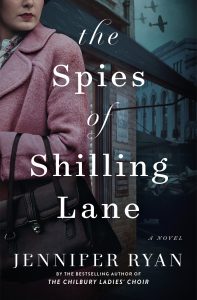The Changing Role of Women in Espionage during World War II: Jennifer Ryan’s The Spies of Shilling Lane
 The Spies of Shilling Lane (Crown, 2019) is an exhilarating spy thriller and the touching coming-of-middle-age story of a woman, who transforms from provincial housewife to London sleuth, after her daughter goes missing during World War II. When asked for the inspiration behind such an original mixing of genres, author Jennifer Ryan mentions her own beloved grandmother’s divorce, as well as an article she chanced upon in a newspaper: “I read about an old lady who died in London, and beneath the floor in her attic they found a Second World War semi-automatic Sten gun complete with ammunition. She had been a spy, both during and after the war. My mind brimmed over with questions. Who was she? What did she do? How had she kept this secret? … Meanwhile, a series of MI5 files were declassified, which meant that I could find them in the National Archives.”
The Spies of Shilling Lane (Crown, 2019) is an exhilarating spy thriller and the touching coming-of-middle-age story of a woman, who transforms from provincial housewife to London sleuth, after her daughter goes missing during World War II. When asked for the inspiration behind such an original mixing of genres, author Jennifer Ryan mentions her own beloved grandmother’s divorce, as well as an article she chanced upon in a newspaper: “I read about an old lady who died in London, and beneath the floor in her attic they found a Second World War semi-automatic Sten gun complete with ammunition. She had been a spy, both during and after the war. My mind brimmed over with questions. Who was she? What did she do? How had she kept this secret? … Meanwhile, a series of MI5 files were declassified, which meant that I could find them in the National Archives.”
Although Ryan pays tribute to her literary forbears, among them, Dorothy Sayers, Agatha Christie, Virginia Woolf, E.F. Benson, and P.G. Wodehouse, she points to another group of writers who aided the creation of her Shilling Lane heroines: the diaries and letters of ordinary women written in the course of the war. Ryan mentions in particular the journals of Mrs. Nella Last, a 49-year-old housewife, who lived a quiet life in the busy mid-sized town where her domineering husband managed a factory when war broke out. “Nella became involved in the Women’s Voluntary Service, setting up mobile canteens for soldiers, raising money for the hospital, and visiting the bereaved. By the end of the war, she vowed never to let her husband or any other man dominate her ever again. It is her metamorphosis that inspired me to write this story; how women of all ages changed their way of thinking about themselves, going from dependent housewives to powerful, resourceful individuals.”
Of course, Ryan’s main protagonists, Mrs. Braithwaite and her daughter Betty, engage in significantly more dangerous activities than those advocated by the Women’s Voluntary Service. Eventually, they investigate a spy ring, whose members are Englishmen and Englishwomen in sympathy with the fascists. These individuals are the ‘enemies within,’ planning and carrying out attacks on British institutions, facilities, and persons from inside Great Britain. Their portrayal in The Spies of Shilling Lane is effective and chilling; the result, so Ryan attests, of her close study of the files kept on members of fascist organizations during World War II. “The reading was fascinating,” she says, “and I closely based many of my fascists on the real ones… Many of them were obsessed with Hitler, although some of the leaders were more interested in opportunities for power. It made riveting reading, and I wanted to follow it as closely as I could.”

Jennifer Ryan
Against these villains, Ryan sets the formidable force of Mrs. Braithwaite’s daughter Betty, whose portrayal is based on women becoming useful to intelligence organizations during World War II. “Before then, the only role for a woman in espionage was as a sexual lure. By 1940, there was an urgent need for young, stealthy people to infiltrate underground anti-government groups. Those people were women. They came from all over the country. Young Betty Braithwaite, at twenty, is among these. Clever and keen to stretch herself beyond the usual mundane women’s jobs, she quickly finds a spot in MI5, from whence she was selected for more special work. She is based on Joan Miller, whose memoir was published posthumously in Ireland, MI5 trying to block it all the way.”
By contrast, Mrs. Braithwaite, who comes to London to visit her daughter only to discover that Betty has disappeared, is unprepared for the horrors of the London Blitz. As she turns detective in order find her beloved child, “she isn’t based on anyone in particular, although perhaps her bombastic snobbishness is reminiscent of one Mrs. Chantrell, an overbearing friend of my grandmother’s,” Ryan elucidates. “As with my previous novel, The Chilbury Ladies’ Choir, I used the stories from my grandmother and other women who remembered the war to form a backdrop of what it was like to be a woman at that time. Among the horrors, it was a time of opportunity, changed roles, and freedom. It was a time to rethink their roles and the society in which they lived. I wanted to give this gift to Mrs. Braithwaite, enable her to reconsider her life and her relationship with her daughter.”
Asked whether there will be a sequel, Ryan reveals that she is delighted by reviews in The New York Times, Kirkus, and Publishers Weekly saying that readers of The Spies of Shilling Lane will be left wanting more. “Perhaps they won’t have too long to wait!” she hints in closing, giving her fans hope that she will soon take them on another enthralling literary adventure with Mrs. Braithwaite and her friends.
About the contributor: Elisabeth Lenckos, PhD, is the editor of Jane Austen and the Arts and The Literary World of Barbara Pym. She is on the HNS Social Media Team and reviews for the society. She is currently at work on a novel about two adventuresses in 18th-century India.






